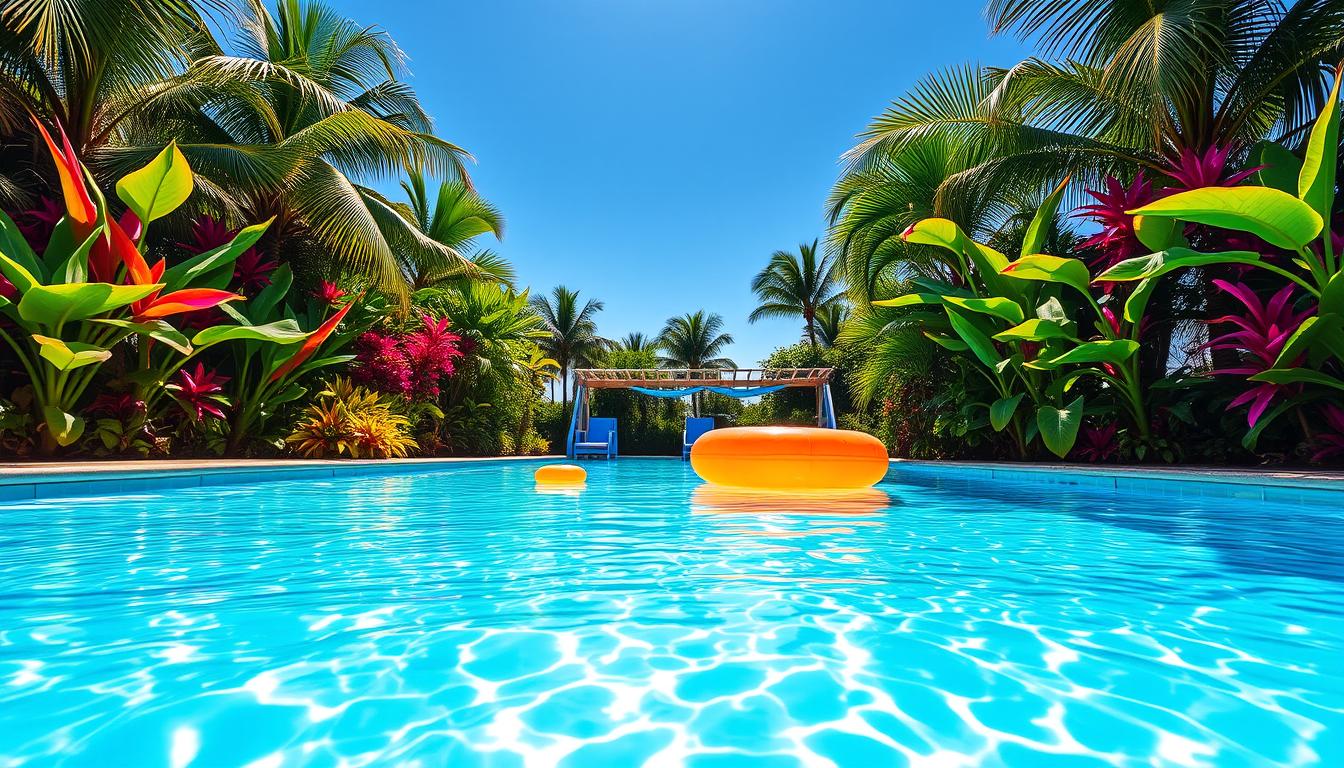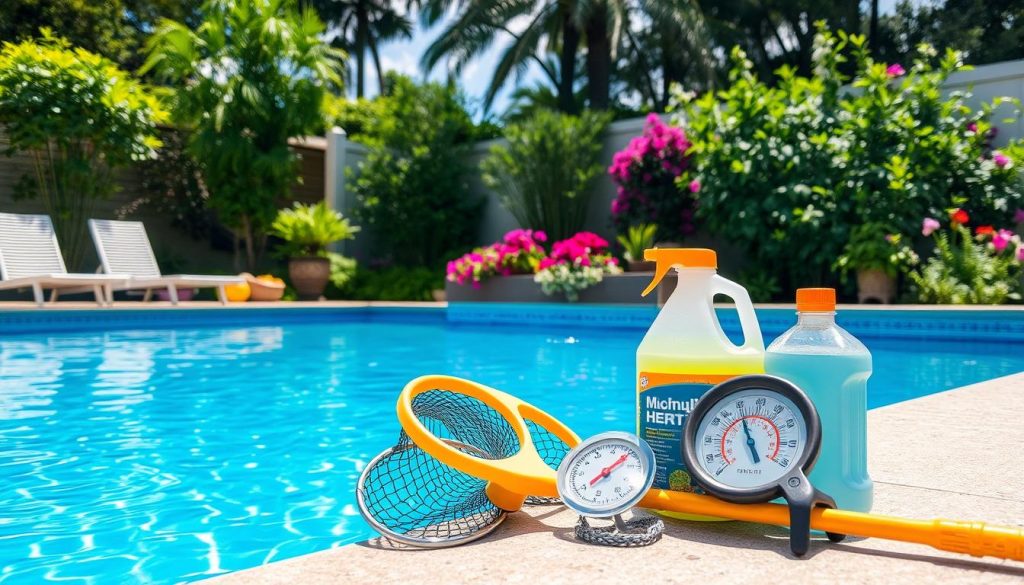
Opening a pool can take up to a week. Maintaining a pool can feel like a full-time job. But we can make our pool water blue again with a few simple steps.
Algae growth is common in pools due to low chlorine levels and sunlight exposure. A broken filter or improper chemical balance can also turn pool water green.
To transform winter green water to sparkling blue, start the opening process early. Begin at least a week before you plan to take your first swim.
Understanding Why Pool Water Turns Green
Pool owners often face the problem of green pool water. This issue stems from various factors. Understanding these causes helps us prevent and treat green pool water effectively.
Proper pool water treatment and maintenance are crucial. These practices keep our pools looking their best. They also ensure a safe and enjoyable swimming experience.

Algae Growth Due to Insufficient Chlorine
Algae thrive in pools with low chlorine levels. This is a main reason for green water. Maintaining proper chlorine levels is key to preventing algae growth.
Here are some important facts to remember:
- Swimming pools turning green due to a lack of chlorine is a common issue; maintaining free chlorine levels between 2.0 and 3.0 parts per million is recommended.
- Pool water should be tested at least once or twice a week to ensure chlorine levels are adequate.
- Shock treatments with granular chlorine (calcium hypochlorite) are suggested at least once every two weeks, or more frequently in summer.
Sunlight’s Role in Promoting Algae
Sunlight greatly promotes algae growth in pools. Warm, sunny conditions create an ideal environment for algae. Regular pool shocking and algaecides help keep algae away, even during sunny months.
Malfunctioning Filters and Improper Chemical Balance
Faulty filters and unbalanced chemicals can cause green pool water. Maintaining filtration systems and balanced water chemistry prevents these issues. Consider the following:
| Filter Type | Maintenance Tips |
|---|---|
| Sand Filters | Require occasional backwashing; issues like sand “channeling” or damaged backwash valve gaskets can lead to poor filtration and green water. |
| Diatomaceous Earth (DE) Filters | Can swiftly clear green or cloudy pools, but issues can arise if DE bypasses the filter and enters the pool, requiring repair. |
| Cartridge Filters | Effective at filtering small particles; a rise in pressure without improved water clarity may indicate debris passing through the filter, necessitating inspection. Should be cleaned every 2 to 6 weeks. |
Proper chemical balance is vital for preventing algae growth. It also ensures swimmer comfort. Here are key points to remember:
- If pH levels are high, chlorine reacts slowly, leading to algae growth and green water; low pH levels can cause rapid chlorine dissipation.
- High levels of Stabilizer (Cyanuric Acid) can result in slow chlorine reactions, making it less effective against algae. Chlorine stabilizer levels should be maintained between 30-50 ppm before adding pool shock.
- At a pH level of 8, chlorine is only around 25% effective.
Knowing these factors helps us maintain clean pools. We can take steps to prevent green water. Regular treatment, maintenance, and cleaning keep pools inviting and healthy for all.
How to Make Pool Water Blue
Want to restore your pool’s crystal-clear state? You can transform your murky pool into a sparkling oasis. Follow these steps to make your pool inviting and safe for swimmers.
Shock the Water with Chlorine Tablets
Start by shocking the water with chlorine tablets. This eliminates algae and other contaminants. Follow the package instructions to determine the right number of tablets.
The treatment duration depends on your pool size and algae growth severity. This process kills algae, preparing the pool for the next cleaning steps.
Remove Dead Algae by Vacuuming or Using Flocculants
After killing the algae, remove it from the pool. This prevents it from sinking and creating a breeding ground. Use a manual vacuum or flocculants to remove dead algae.
Flocculants clump dead algae together, making removal easier. Clean your filter thoroughly after this process to ensure optimal performance.
Maintain Proper Chlorine Levels with Chlorinating Tablets
Add chlorinating tablets to your floater or skimmer. Follow the manufacturer’s recommended dosage. These tablets slowly release chlorine into the water over time.
Regularly test your pool water using test strips. Ensure chlorine levels stay within the ideal range of 1-3 ppm (parts per million).
Apply Algaecide to Prevent Algae Regrowth
Use algaecide to prevent algae from regrowing. Apply it 24 hours after shocking the pool. Follow the instructions on the product label.
Add algaecide weekly as part of your regular pool maintenance. This helps maintain a healthy, algae-free pool.
Test and Balance Water Chemistry for Swimmer Comfort
Regularly test and balance your pool water chemistry. Check pH, alkalinity, calcium hardness, and cyanuric acid levels with test strips.
Use appropriate balancers to adjust levels outside the ideal range. This ensures comfort and prolongs pool equipment life.
| Parameter | Ideal Range |
|---|---|
| pH | 7.2 – 7.6 |
| Alkalinity | 80 – 120 ppm |
| Calcium Hardness | 200 – 400 ppm |
| Cyanuric Acid (Stabilizer) | 30 – 50 ppm |
Conclusion
Keeping pool water clear and blue requires regular maintenance and effective treatment. By following these cleaning tips, we can turn a green pool into a sparkling oasis. Shocking the water, removing algae, and balancing chemicals are crucial steps.
Consistency is vital for proper pool care. Create a routine for testing water and applying treatments regularly. This helps prevent algae growth and keeps the pool clean.
New pool lining materials can enhance the water’s natural blue color. Options range from crisp whites to elegant dark hues.
Staying proactive in pool maintenance creates a safe and fun swimming environment. A little effort goes a long way in keeping water sparkling blue. Let’s commit to proper pool care and enjoy our backyard oasis.







